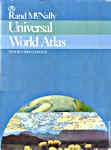

Amerigo Vespucci
Con Artist of the Sea
He made believe he discovered mainland America in 1497, and got it named after him.
But it was Columbus who found the continent, on his Third Voyage of 1498.
SHIPS AND THE SEA
VESPUCCI, AMERIGO (1451-1512), a Florentine merchant-adventurer whose selfgenerated claims as an explorer and as the first white man to reach the mainland of America in June 1497 have been doubted owing to the impossible distances and positions quoted in the letters in which the claims were made. Nevertheless it is from the latin version of his name, Americas, that the New World takes its name.
Vespucci's letters described four voyages in all to the New World, the first a private venture, the second under the Spaniard Alonzo de Ojeda, and the last two in the service of King Manoel of Portugal. In 1505 he became a naturalized Spaniard. That his accounts of his voyages had a basis of truth and that he was an experienced navigator by that time is indicated by his appointment on 6 August 1508 as piloto mayor, or chief pilot, of Spain, an office which he held until his death.
The Oxford Companion to Ships and the Sea
Oxford University Press, Oxford, 1976, p 913
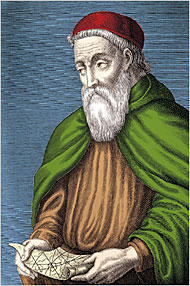
THE HONEST SHIPCHANDLER
Contrary to what you might expect, Amerigo Vespucci and Cristobal Colon were friends. Maybe not in the last place because Vespucci seems to have been something rather rare, an honest shipchandler. When Waldseemüller called the new continent America on his famous 1507 map, this may have been tongue-in-cheek. Thereby proving once again that such joking is dangerous, as the name stuck; even though Waldseemüller himself took off the name in a following edition, seven years later. Not only that, there are people who get mad and pick a fight if you will not accept that it was Vespucci who discovered the South American continent, or at least Curaçao (not such a big deal, that, anyway).
What Vespucci must have thought about the gang of piratical explorers he got involved with, is anybody's guess. Maybe it gave him a reason to leave the expedition and go exploring on his own.
Morison does not agree at all with the navigational qualities ascribed to Vespucci in Ships and the Sea: "[his] pretentious apparatus of celestial navigation [is] so much dust thrown into the eyes of important Spaniards." Knowing Spain at the time, this job would have been no more than a sinecure anyway, like the British
Vice-Chancellor of the Country Palatinate of LancasterWodehouse mentions (in Uncle Dynamite). What do those important people know, anyway?
The European Discovery of America: The Southern Voyages, Samuel Eliot Morison
Oxford University Press, Oxford, 1974
or the advantage of photographs
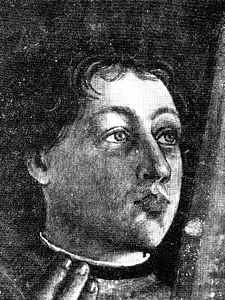 | 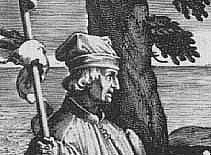 left: as a boy center: "discovering" America right: by Waldseemüller |  |
| it's not all Vespucci's fault |
| You may notice a rather strong anti-Vespucci feeling here. This is caused less by Vespucci himself, and more by those maniacs who desperately want to believe in his claims - rather than give Columbus the credit he deserves. In the first place, the lies ascribed to Vespucci may not even have been his lies. It might very well be not a single one of the so-called Vespucci letterswas written by him. (Copyright, with the recent invention of the printing press, was in just such a turmoil as it is these days, now caused by the digital revolution.) Second, Vespucci was the first man to realize there was such a thing as an American continent. Columbus himself, until the end of his days, thought he had arrived in Asia. Finally, the Vespucci stories on his travels still remain very entertaining, containing many details on the culture of the Amerindians; something you can't say about most of his contemporary discoverers. |
more Vespucci prints
timeline of a liar's life
1454 Born in Ognissanti, Florence 1454
1491 to Sevilla as head employee of de Medici affiliate Juanto Berardi
1495 head of the house, merchant banking and shipchandling
1497 "First Voyage"
This voyage was a complete invention, if not by Vespucci, and includes authentic bits from The "Second Voyage" with Alonso de Ojeda, 1499. The report (now lost) of Columbus' 1498 Third Voyage had not yet been printed; on that voyage Columbus discovered the Gulf of Paria: the mainland of America, albeit without realizing he had done so. The claims that Vespucci did really can't be substantiated.
Mundus Novus to Lorenzo de Medici, the Bartolozzi letter, 1504-1506.
Some people feel Vespucci himself did not write allhisletters; in which case this one still is a falsification. German author Stefan Zweig, in his 1942 Comedy of Errors, figures all the Vespucci letters are fakes.
1498 Vespucci helps outfitting Columbus' Third Voyage
It's only in that same year that India is reached by sea from Europe for the first time, by Vasco da Gama
1499 First Voyage with Alonso de Ojeda ("Second Voyage")
Vespucci probably helped financing. He left the rest of the expedition in Hispaniola (Haïti/Santo Domingo) (map, H) and arrived back in Sevilla in 1500, before de Ojeda, where the voyage was described as if expedition leader de Ojeda had not even been present.
In the Juan Vaglienti letter (1500), Vespucci states he sailed 2350km SW from Cádiz (map, *), which would have taken him to Antofagasta, across the continent in Chile (map, AC).He certainly did not realize, contrary to his claims in the 1505 Bartolozzi letter, that there's a continent in between. Magellan only discovered how to get there by ship in 1520, on his circumnavigation.Vespucci also describes a technically impossible method of determining his position; the results would have put him at the Galápagos (map, G). That's better than the hoary navigator's joke "Take of your hats, gentlemen; we're in St. Peter's of Rome"—but not much better.
I was amazed to find this internal evidence that the Bartolozzi 1505 letter can only have been a complete fake. As only too often, so much for so-calledscholarswho just repeat each other - they never mention this. This is even worse with maniacs who, against all logic, stubbornly keep defending their pet theories, disregarding all contrary arguments.
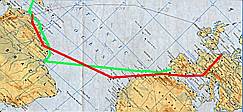
green: Ojeda 1499 route
red: KLM Fokker F-XVIII Snip 1934
1501 Second Voyage ("Third Voyage")
Don Manuel, king of Portugal, sent Gonçalo Coelho to Brazil to follow up on Cabral's discovery. Vespucci was "passenger and self-appointed navigation officer".
The expedition departed from Lisboa on 10 May 1501 (map, *), took in wood and water in Bezeguiche, sailed SW by S for 700 leagues, raised Fernão de Noronhao 16 August, and the following day Brazil. Vespucci gives the latitude as 5º south, but it may have been 5º29', Cabo San Roque. Coelho sailed on to 8º south, Cabo Santo Angostinho. Reached 23º S Guanabara Bay (Rio de Janeiro), 1 January 1502 (map, Rio). It first appears on the Piri Re'is map as Sano Saneyro. They then sailed down to Cananeia, 25º S, but Vespucci calculates to 32º S (Rio Grande). The flagship then returns to Lisboa, and Vespucci claims he takes over navigation completely. Two ships, with Coelho commanding, depart from Brazil 13 February 1502. April 3 (2700km out), Vespucci notes "South Pole [Star] elevation 52º", Great and Little Bear invisible. (They disappear at 10º S.) 53º may be a printing error for 23º S; if correct, this would have been South Georgia (1620km SE from the Falklands, map, SG), but it likely is Ilha do Trinidade island at 20º S (map, T). 10 May 1502 arrived at Sierra Leone (map, SL), back in Lisboa 7 September (map, *).
From the printed Lettera to Soderini letter, 1504

Based on Rand McNally's Universal World Atlas, 1988, page 5
Many requests for a
mapof Vespucci's travels reach us via the search engines.
But he just cannot have been in some places, as he claims, by any possible route.
1503 Third Voyage ("Fourth Voyage")
10 May, departure from Lisboa (map, *) of 6 ships under commander Gonçalves Coelho; Vespucci was captain of one ship. Destination was Melaccha, Indonesia, way beyond the continent of America across the Pacific. Sailed to Cabo Verde (map, CV) and from there to Sierra Leone (map, SL). Sailing SSW for 3080km found an island at 3º, probably Ascensión, 7º55' S by 14º25' W (map, A). There they lost the flagship on a reef and only two ships arrived at Todos os Santos (Bahía) Brazil, in November. They continued down to what is stated as 16º S (but must have been Cape Frio, 23º S) to arrive back in Lisboa 77 days later on 28 June 1504.
1504-1505 Vespucci writes his two most famous printed letters:
- Lettera to Soderini
- Mundus Novus to Lorenzo de Medici, the Bartolozzi letter
Both letters do not even mention Gonçalves Coelho, but still manage to insult him.
Genoa cartographer de Maiollo names Brazil Tera de Gansalvos Coigo locater Santa Croce ("Land of Gonçalves Coelho").
1505 Vespucci becomes a naturalized Spaniard.
1507 Walseemüller puts Vespucci's name on his America map.
1508 Vespucci becomes Piloto Mayor (chief pilot) of Spain.
1512 Dies, regretted by almost all.
The European Discovery of America:
The Southern Voyages
Samuel Eliot Morison
Oxford University Press, Oxford, 1974
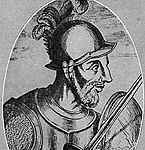
Alonso de Ojeda
fellow voyager
charts & maps

SEARCH this site or the Web

copyright notice
all material on this site, except where noted
copyright © by , curaçao
reproduction in any form for any purpose is prohibited
without prior consent in writing
